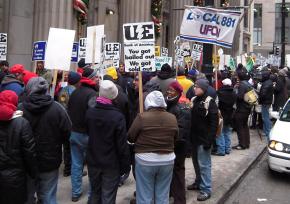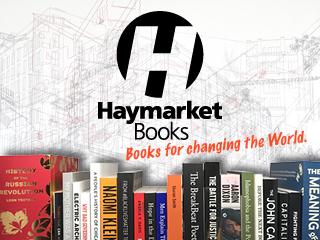The meaning of the Republic victory
assesses the impact of the workers' victory in the Chicago window factory occupation.
THE FULL implications of the workers' breakthrough victory at Republic Windows & Doors are still unclear, but a few lessons can already be drawn.
First, by occupying their plant, the workers--members of the United Electrical, Radio and Machine Workers of America (UE) Local 1110--gained enormous leverage over the owners and their creditors. The action forced the company's banks to pay for severance pay legally required in a plant closure.
Overnight, a factory occupation--something usually reserved for labor history books on the 1930s and nostalgic speeches at union conventions--became a focal point for working class resistance amid a profound economic crisis.
There is, of course, an important difference with the workers' takeover of Republic and the most famous sit-down strike in U.S. history, the occupation of General Motors' main plant in Flint, Mich., in 1936-37. Unlike GM, which kept operating during the Great Depression of those years, Republic had shut its doors.
A better comparison for the Republic workers' action, therefore, may be the factory takeovers in Argentina and some other Latin American countries, where workers restarted production under their own control after management tried to shutter their plants during the recession of 2001.

The Republic workers didn't attempt to keep their plant operating--not least because management had already moved out some of the most important equipment, perhaps to the nonunion windows factory that the owners' family recently purchased in Iowa. The union has, however, established a "Windows of Opportunity" fund to explore the possibility of resuming production.
Nevertheless, by seizing control of the owners' property, the Republic workers demonstrated to the rest of the labor movement that workers' power is based at the point of production. In an era in which strike picket lines are more often symbols of protest than serious efforts to stop a company's operations, the Republic workers showed that more militant action can win.
The second key lesson of the Republic victory is the centrality of solidarity action.
Within days--if not hours--the occupation became national and even international news. By the end of the struggle, statements of support had appeared from labor organizations all over the world, including the main trade union federations in France and Japan.
At the local level, the factory entrance was the site of a running solidarity meeting involving a wide range of union leaders, union reform caucuses, rank-and-file activists, community organizations, radicals, socialists and religious groups. Organizers compared notes, strategized and made plans--not only to build support for Republic workers, but about other struggles as well.
THE THIRD point to make about the struggle is that it showed how organized labor can speak for the interests of the entire U.S. working class, even though unions represent just 12.1 percent of workers and 7.5 percent in the private sector.
Thanks to the Republic workers' struggle, an ordinarily hostile national media focused on the fact that Republic's main creditor, Bank of America, had cut off the factory's line of credit despite the infusion of $25 billion of taxpayer money into that bank as part of Congress' bailout of Wall Street. Politicians and bankers, therefore, felt pressured to resolve the issue in workers' favor.
Ordinarily, workers in this situation can wait for years to receive the money due them--if they ever do. But Republic workers forced Bank of America and other creditors to come up with nearly $2 million in less than a week, even though the banks had no legal obligation to do so.
A fourth aspect of this victory is the key role of immigrant workers in the U.S. labor movement. The overwhelming majority of the Republic workforce is Latino, and most are immigrants. Yet in an increasingly repressive atmosphere of workplace immigration raids and deportations, these workers were willing to risk arrest or worse in order to stand up for themselves.
The big marches against anti-immigrant laws played a role in boosting workers' confidence. "We learned that we had rights," one worker said.
Finally, the Republic struggle underscored the fact that class-struggle, social-movement unionism must be at the heart of any serious revival of the labor movement. After decertifying a mob-dominated union, the workers brought in UE, a union with radical roots in the 1930s.
UE eventually grew to be the largest union in the old Congress of Industrial Organizations (CIO), before withdrawing amid the anti-communist witch-hunts. In the 1950s, UE was raided by rivals in the AFL and CIO, and greatly reduced in size.
Today, it numbers just 35,000 nationally--a far smaller number than in the vast, bureaucratic "locals" of the Service Employees International Union (SEIU). And where SEIU seeks clout through political deals and partnership with employers, UE promotes democratic, militant unionism.
The victory at Republic flowed directly from the rank-and-file union democracy practiced in UE Local 1110. If the Republic workers' win has an impact on the rest of the labor movement, it will be because more union members follow their fighting example.


